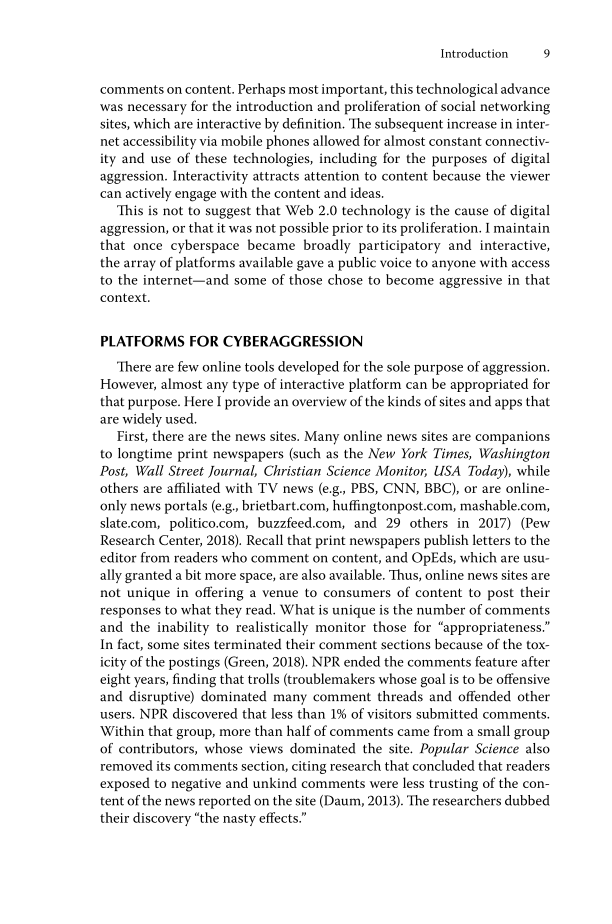Introduction 9 comments on content. Perhaps most important, this technological advance was necessary for the introduction and proliferation of social networking sites, which are interactive by defi nition. Th e subsequent increase in inter- net accessibility via mobile phones allowed for almost constant connectiv- ity and use of these technologies, including for the purposes of digital aggression. Interactivity attracts attention to content because the viewer can actively engage with the content and ideas. Th is is not to suggest that Web 2.0 technology is the cause of digital aggression, or that it was not possible prior to its proliferation. I maintain that once cyberspace became broadly participatory and interactive, the array of platforms available gave a public voice to anyone with access to the internet—and some of those chose to become aggressive in that context. PLATFORMS FOR CYBERAGGRESSION Th ere are few online tools developed for the sole purpose of aggression. However, almost any type of interactive platform can be appropriated for that purpose. Here I provide an overview of the kinds of sites and apps that are widely used. First, there are the news sites. Many online news sites are companions to longtime print newspapers (such as the New York Times, Washington Post, Wall Street Journal, Christian Science Monitor, USA Today ), while others are affi liated with TV news (e.g., PBS, CNN, BBC), or are online- only news portals (e.g., brietbart.com, huffi ngtonpost.com, mashable.com, slate.com, politico.com, buzzfeed.com, and 29 others in 2017) (Pew Research Center, 2018) . Recall that print newspapers publish letters to the editor from readers who comment on content, and OpEds, which are usu- ally granted a bit more space, are also available. Th us, online news sites are not unique in off ering a venue to consumers of content to post their responses to what they read. What is unique is the number of comments and the inability to realistically monitor those for “appropriateness.” In fact, some sites terminated their comment sections because of the tox- icity of the postings (Green, 2018). NPR ended the comments feature after eight years, fi nding that trolls (troublemakers whose goal is to be off ensive and disruptive) dominated many comment threads and off ended other users. NPR discovered that less than 1% of visitors submitted comments. Within that group, more than half of comments came from a small group of contributors, whose views dominated the site. Popular Science also removed its comments section, citing research that concluded that readers exposed to negative and unkind comments were less trusting of the con- tent of the news reported on the site (Daum, 2013). Th e researchers dubbed their discovery “the nasty eff ects.”
Document Details My Account Print multiple pages
Print
You have printed 0 times in the last 24 hours.
Your print count will reset on at .
You may print 0 more time(s) before then.
You may print a maximum of 0 pages at a time.




















































































































































































